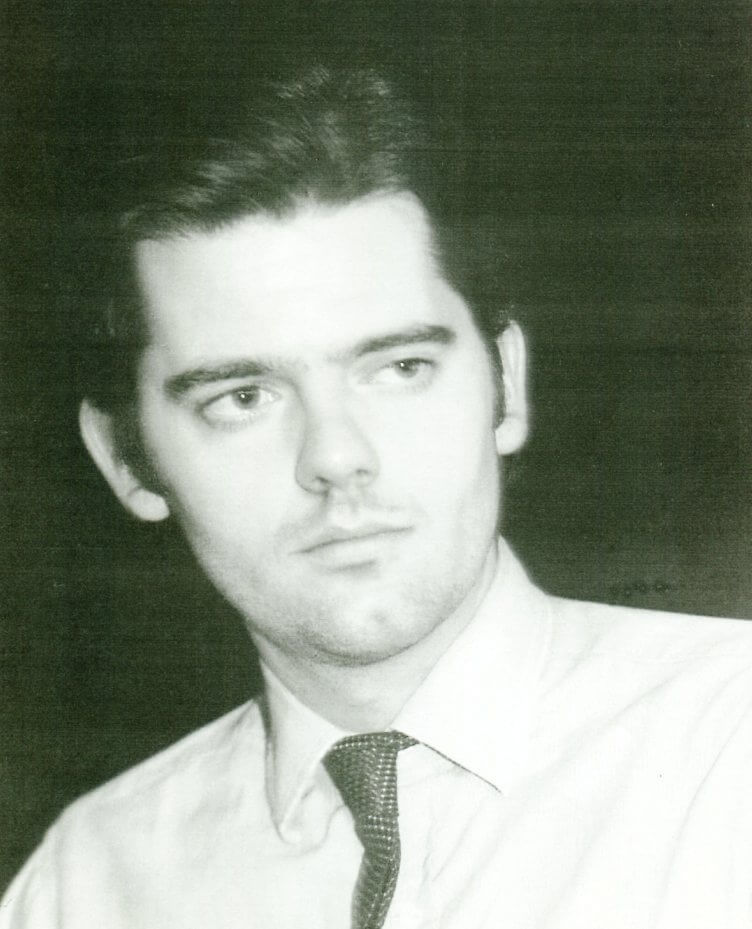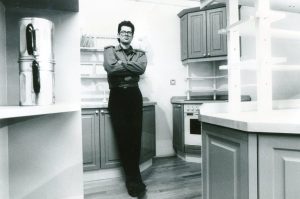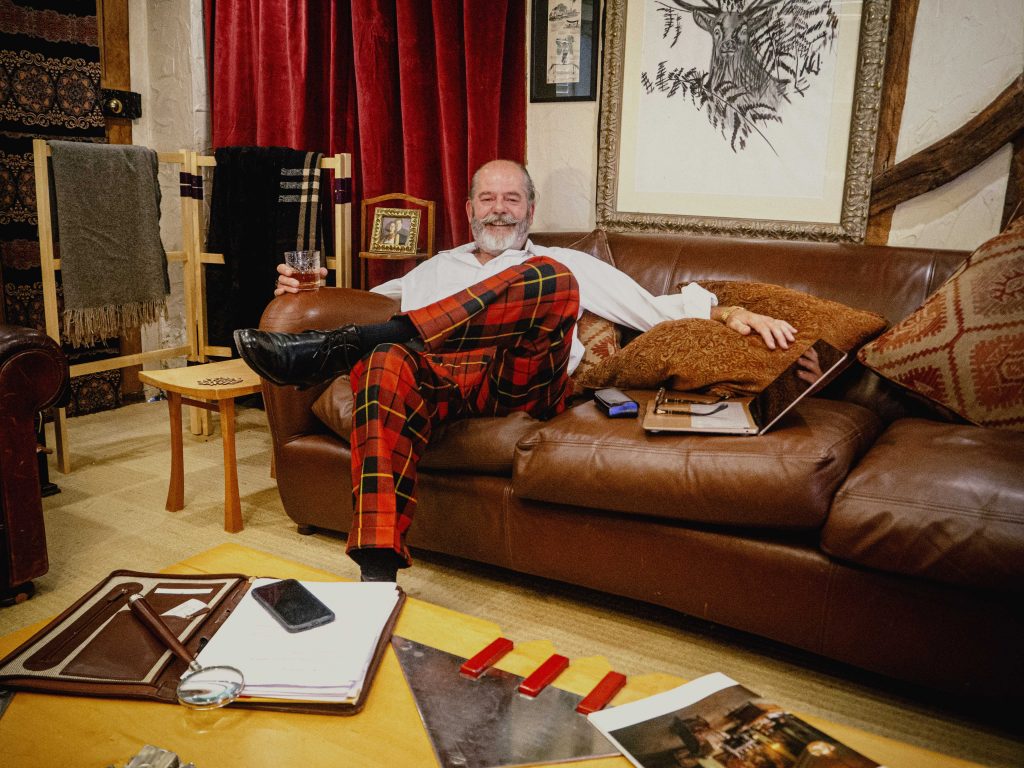Mark St John Arnold Lewis was born December 4, 1957. He was born in a British Forces Hospital in Nicosia, Cyprus. His father was then a Sergeant serving in the Grenadier Guards. His mother was a war time Bletchley Park veteran1. He has two older siblings, both of whom now live in North America.
He struggled through school. Like most forces’ children, he attended numerous fundamental educational facilities, afforded to him either in barracks or locally whilst moving from army quarter to quarter in various countries around the world including Hong Kong, Germany and parts of the UK. By the age of 17, Lewis was to have attended 7 different schools (and moved house 10 times).
In 1969, unable to read or write, aged 11, having moved to Putney (South London), he started secondary school Wandsworth School, one of the UK’s first comprehensive schools. With two thousand schoolboys, Lewis was identified as being bright on admission. However, he was behind the curriculum, and after a week, the headmaster called him out of classes. His report from junior school had arrived, identifying him as academically inept, and he was immediately put into the bottom stream, a class of similarly disadvantaged boys.
Russell Burgess, Director of Music at the School, had created the 200 strong Wandsworth School Boys’ Choir. Each new year all new students were auditioned, and he handpicked candidates for the Wandsworth Boys Choir. Lewis was chosen. Burgess’ friend, Benjamin Britten would regularly try out new works with the choir. Lewis’ participation was miraculous because he couldn’t read the lyrics let alone the music, but he had a fine ear. Following the indications on the music sheets and keeping up with the other sopranos, and managed well enough to participate fully, including ITV, BBC and radio broadcasts, album recordings and concerts at most of the significant venues in London, Surrey and Sussex. Lewis claims to have been in the choir when Burgess and Britten recorded The Golden Crusade Album.
According to Lewis himself, there were advantages for the youngster to being in the choir. As the music master wanted the choir for the full hour of the lunch break, the choristers had lunch before the others, ensuring that there was not only a good selection of food, but the chances of losing lunch money reduced considerably if it hadn’t been stolen during the morning break (which is where Lewis learned how to fight in school corridors). The choir defied norms as Lewis, along with many of his compatriots, stood in DMs with skinhead haircuts, singing fine choral works. Some of the elite boy sopranos and altos (approx. 20) would visit Benjamin Britten at his home near Glyndebourne to practise finer, more sophisticated, pieces.
In 1970, Lewis left after only a year and a half, when his father was posted to Caterham, Surrey, while his regiment, The Grenadier Guards, went on regular unaccompanied (by family) tours in Northern Ireland. Lewis attended de Stafford secondary mixed school. According to Lewis, the girls there formed a welcome distraction from the futility of academia.
A further move to Hong Kong further “provided the excitements adolescents could have in such an exotic place” (Lewis, April 1920). It was a short posting, and he returned to the UK in 1975 with an Art “0” level obtained at St George’s School in the New Territories. Lewis consolidated his artistic talent at Brooklands Technical College (now Brooklands College) in Weybridge, Surrey, completing a one year “A” level intensive Art course.
In 1992, Lewis married Hilary Beuzeval, then design manager of accessories Burberry, and lately Director of Product, Leather Goods, Asprey. They have two sons, Freddie and Alfie.(This was his second marriage, the first being to Fiona Spencer, in 1982, Divorced 1990).
In 2008, the family moved from North London to West Sussex. By 2010, Lewis had been diagnosed with prostate cancer, which forced a pause in his career.
Disability
Lewis was born with a sight impairment, astigmatism in both eyes. He was unable to see much detail of anything, including the white chalk marks on a black board. This was not, however, diagnosed until he was 11, when he began fainting in school assemblies, apparently common with this condition. Prior to moving on to secondary school, Lewis had already failed his 11 plus before finally being issued a pair of National Health spectacles.
In 1989, Lewis was diagnosed with dyslexia at the late age of 32 by Adrian Stokes, Director of the Dyslexia Teaching Centre in Kensington10. According to Lewis, the revelation helped him unravel previously internalised emotional and anger issues, assisted by a long period (seven years) in psychotherapy.
Career

West Surrey College of Art Foundation 1977
Lewis was admitted onto the West Surrey College of Art’s Foundation course under a special provision afforded by the Principle there, despite his academic qualifications being limited to an Art “A” level and a few other “0” levels. Lewis earned a distinction, and the Principal and other course tutors encouraged him to progress further.
Kingston Polytechnic BA (Hons) Three Dimensional Design (Furniture) 1980
Admitted under a special provision, Lewis graduated with a BA (Hons) at Kingston Polytechnic’s degree course in Three Dimensional Design (Furniture). He narrowly missed a First having researched the work of the little known art nouveau designer and artist Henry van de Velde. The art history tutor, a leading expert in van de Velde’s work, marked him down for the lack of original content in his dissertation.
Other talented designers at Kingston at the same time include Matthew Hilton, James Irvine, Simon Morgan and Jasper Morrison. Morgan and Irvine, (along with George Sowden and Ettore Sottsass) established Memphis Milano (the Memphis Group, a creative outlet for functional designers.
Johnny Grey Design

A Design Council show introduced Lewis to Johnny Grey, designer to London’s wealthy society. Lewis became an associate of Johnny Grey Design in 1982.
His work included prestigious projects such as architect Charles Jencks and his wife Maggie Keswick Jencks post-modern ‘palace’ in Holland Park12,13; and Lady Pamela Harlech’s kitchen (also in Holland Park). Lady Pamela, an American famous for her beauty and style, was the wife of David Ormsby-Gore, 5th Baron Harlech.
Lewis further contributed to the bedroom range of furniture for upmarket British furnishing store, Heals. Lewis designed the Oriental four poster bed which was prominently featured by Heals in the corner window at the launch of the furniture range.
The ‘Home Office’ collection was exhibited at Robin Guild’s showrooms in Pimlico. (Guild co-founded Designers Guild with his wife, Tricia Guild, OBE. They later divorced.
Becher Joinery 1982-83
Lewis spent a short period working as the production manager for Becher Joinery in Chiswick making the interior shop-fitting systems for The Body Shop.

Lewis & Horning 1983-87
In a short-lived partnership with Jonathon Horning, Lewis set up Lewis and Horning, a name retained despite Horning moving on very shortly after launch. (David Challoner, sometimes referenced publicly with the Lewis and Horning name, created the first display kitchen in the showroom.)
Lewis & Horning, in London’s Drury Lane, was the UK’s first contemporary kitchen and kitchen accessory retail business. The first showroom opened in 1983, and the enterprise grew to incorporate workshops and studios in Wandsworth and a showroom in the Design Centre, Islington.
The company became particularly known for Lewis’ ‘unfitted kitchen’ concept.

The company undertook interior refurbishment projects as a design build contractor, including for the Scotts Group Plc together with various other large commercial and domestic interior projects.
The business closed in 1987 when the economic downturn removed the company’s viability as a retail unit. Directors Ted Heath (production director) and his assistant, Richard Creed, continued operating from the company’s artisan workshops in Wandsworth (trading as H & C) after the Covent Garden and Design Centre showrooms were closed.
Independence: Lewis Design London
Leaving Lewis and Horning, Lewis established himself as an independent design consultant in the commercial sector (initially as Mark Lewis Design and Production), implementing various projects. He was retained by large corporations such as DeBeers, Project Office Furniture Plc, Digital Equipment Corporation (UK), City Industrial ltd, The Business Design Centre, Islington, and by workplace ergonomic specialists Colebrook, Bosson & Saunders (CBS).
Despite his dyslexia and early sight impediments and reading issues, Lewis also contributed to various design journals as a freelance writer reporting on design events in New York and London, and creating product reviews for The Interior Designers Handbook. He notably drew fire from designer Terence Conran for a review of the Design Museum.
Lewis took on consultancy roles as a domestic refurbishment design/build contractor between 1995 and 2009, when he was diagnosed with cancer.
After a long period of treatment and recovery, Lewis returned as Lewis Design London and in April 2020 began work to produce and market a hardwood kitchen accessory range, coming ‘full circle’ with the design of a new, upscale chopping board – one of his earliest successes was also with a well designed chopping board.

MA in Design Research for Disability 1995
Lewis developed an interest in designing for people with a disability whilst working with CBS and completed an MA in Design Research for Disability at London Guildhall University in 1995. He developed an athletic system for people with spinal cord injuries and/or mild forms of cerebral palsy.
Notable exhibitions and Presentations
The class of 1980: The Director of the Design Council exhibited Lewis’ work in the Haymarket, London.
1983-1987 Lewis’ contemporary kitchen furniture ranges and accessories were on show in the Contemporary Kitchen Furniture Emporiums in London’s Drury Lane and at the Design Centre Islington, including the modular kitchen furniture range of ‘unfitted‘ (modular) kitchens, “Chattel” Black with maple trim kitchen units were shown in the Design Council in the Haymarket and then became a travelling display.
1986/1987 Further kitchen display at the Design Centre. This display, which became known as the ‘Amazing blue kitchen’. later appeared in various magazines.
1981/2 The “Home Office” collection was exhibited at Robin Guild’s showrooms in Pimlico. (Robin Guild co-founded Designers Guild with his second wife, Tricia Guild.)
November 1985 Interbuild, Stand 7832, Lewis and Horning.
2013 Grand Designs Live: The Kitchen Cabinet (an audience address).
Award
1984-5 Design Council British Design Award for Design Excellence, kitchen range.
Selected projects
Refurbished the restaurant interior of Scott’s (restaurant), Mayfair (1980s).
Restaurant interior of J. Sheekey’s restaurant in Covent Garden (1980s).
Restaurant interior of Drones restaurant in Belgravia (1980s).
The ‘Home Office’ collection was exhibited at Robin Guilds’ showrooms in Pimlico.
Kitchen design and adjoining two mews houses in Belgravia for restaurateur Nicky Kerman, MD to Scotts Plc, and his wife, Juanita.
Interior of Motcombs in Belgravia, owned by Philip Lawless.
Prototype display models for Herman Miller, Inc.
The restoration of Buxton Memorial Fountain in Westminster Gardens (a project that required matching faded enamel colours).
Bibliography
Mark Lewis (September 1989). “Fact or Fantasy”. What’s New in Interiors (Print Edition).
Mark Lewis. “The Unfitted Kitchen”. Kitchens (Print Edition): 290–291.
Mark Lewis (October 1989). “One More Saturday Night”. What’s New in Interiors (Print Edition).
Mark Lewis. “What Next for Designer’s Saturday”. What’s New in Interiors, December/January 1990.
Maurice Davies v Mark Lewis. “Fact or Fantasy”. Design Museum Magazine (Print Edition).
Various (inc Mark Lewis) > (September 1987). “Designer Views”. Woman and Home (Print Edition).
Mark Lewis. “New York: Design and Attitudes, Exhibition Review”. What’s New in Interiors? (Print Edition): 34.
Mark Lewis (1985). “The Unfitted Kitchen”. Interior Designers Handbook (Print Edition).
Mark Lewis (1992). “Accessories for Our Future”. Interior Designers Handbook (Print Edition).
Mark Lewis (February 1987). “Opinion: Make your Mark”. The Journal (Print Edition). The Design Centre: 298.
References
- Ruth Camilla Armitage Jones, otherwise known as ‘Billy’. She is believed to have worked in Hut 6
- Major Peter Arnold Lewis MBE, late of the Grenadier Guards Obituary (Military)
- Lewis, Mark (1–30 April 2020). “An Interview with Mark Lewis (primary source)” (Interview). Interviewed by Claire Thompson, Family friend.
- Birth certificate, Middle East Land Forces Form A.42B.Number 94, Book 46. Recorded by Major JH Venn Dunn, Officer in Charge, Records Centre GHQ HELF. Birth recorded Jan 17, 1958
- Lewis, Mark (1–30 April 2020). “An Interview with Mark Lewis (primary source)” (Interview). Interviewed by Claire Thompson, Family friend.
- Choir history and website: http://www.wandsworthschoolchoir.org/
- List of albums including the choir: https://www.discogs.com/artist/1065461-Wandsworth-School-Boys-Choir
- The Golden Crusade, Published by Decca in the UK – SET 445 (Vinyl, LP, Stereo ) Released 1970 https://www.discogs.com/Wandsworth-School-Boys-Choir-Russel-Burgess-Benjamin-Britten-The-Golden-Vanity-Childrens-Crusade/release/5633622
- source: Marriage certificate WK035789, The Register Office, Westminster, Entry 144, 28 October, 1992
- History of the Dyslexia Teaching Centre https://www.dyslexiateachingcentre.co.uk/about-us/
- Dr Andrew Arthur, Battle East Sussex (list of publications): https://scholar.google.co.uk/citations?user=JeC5-rEAAAAJ&hl=en)
- KCRW: If you can’t take the kitsch, an obituary to Charles Jencks
- Fuminobu Murakami (2005). Postmodern, Feminist and Postcolonial Currents in Contemporary Japanese Culture (PDF). Routledge. ISBN 9781134246236. Retrieved 2020-03-27.(References the Charles Jencks’ kitchen)
- “Trading now…”. RIBA Interiors (Print Edition). May 1985.
- Becher Joinery, Companies House (UK): https://beta.companieshouse.gov.uk/company/01624592
- Caroline Clifton-Mogg (October 1985). “Lord Kitchener”. Harpers and Queen (Print Edition): 298.
- Victoria Allen (March 1987). “Kitchen Sink Drama”. Sunday Times’ the Magazine (Print Edition).
- “Lewis and Horning: We’ve got the lot”. Interior Design (Print Edition). July–August 1986.
- “Lewis and Horning”. Kitchens and Bathrooms (Print Edition). January 1986.
- “Lewis and Horning, Covent Garden scene”. London Portrait Magazine (Print Edition). February 1985.
- Georgina Howel (November 1983). “Britain’s Answer to The Armchair Critics”. Sunday Times (Print Edition).
- “Recipes for Individual Kitchens Naturally”. Daily Telegraph (Print Edition). April 10, 1984.
- “Lewis and Horning: Something Special”. Kitchens (Print Edition): 19. July 1986.
- “UK Kitchen Firms Look to the Future”. Cabinet Maker and Retail Furnisher (Print Edition): P23. February 21, 1986.
- “Lewis and Horning’s New Showroom in London”. Kitchen Choice (Print Edition). March 1984.
- Bryan Appleyard (March 7–13, 1987). “Kicking Out the Kitsch in Sink”. The Saturday Times (Print Edition).
- “Cuisine Minceur”. Vogue (Print Edition). April 1984.
- “A new star in the kitchen firmament”. Portrait (Print Edition). February 1984.
- “Sexual Imagery Underlies New Dresser Design”. What’s New in Building (Print Edition). August 1985.
- “Kitchen Guide”. House and Garden (Print Edition). November 1985.
- “Kitchens on the Move”. Building Products (Print Edition). September 1984.
- “Shops: Cookery Class”. World of Interiors (Print Edition): 50–52. July 1984.
- “Kitchen Things…White”. A la Carte (Print Edition).
- “You may like this dresser”. RIBA Interiors (Print). September 1985.
- “The Opposite of the Fitted Kitchen”. Homes and Gardens: 26. March 1986.
- “Unfitted Kitchens”. Kitchens and Bathrooms (Print Edition) ). September 1985.
- “Kitchen Units are Designed Not to Fit”. What’s New in Building (Print Version) ). October 1985.
- Nick Band. “A Battle Against the Boxes”. Kitchen and Bathroom Review 1985/1986 (Print Edition).
- “Creative Kitchens”. Observer Magazine (Print Edition). April 21, 1985.
- “A Moveable Possession (Chattel)”. Ham & High (Print Edition). March 1986.
- “Rebellion Strikes Kitchen Design”. What’s New in Building (Print Edition) ). January 1986.
- “Kitchens: Cabinet Decisions (print edition)”. Signature: P66. March 1987.
- “Shopping in Style: All Kitted Out”. Ideal Home (Print Edition). March 1986.
- “Lewis and Horning Custom Built Kitchens”. Design Selection (Print Edition): 105–106. March–April 1986.
- “Front Bench”. Living Magazine (print Edition). January 1986.
- “Trading now…”. RIBA Interiors (Print Edition). May 1985.
- “Project Office Furniture, Companies House reference”
- “Hurry on Down: Icon’s Commercial Design”. Business Design Centre Magazine,1990.
- Jane Gordon (April 29, 1987). “Mark of Nostalgia”. Today Newspaper (Print).
- “The New King of the British Kitchen”. Design Week (Print Edition). July 3, 1987.
- The Interior Designers Handbook
- Lewis Design London
- “Knife Block”. London Portraits (Print Edition). February 1985.
- “Chop, Chop”. Gifts and Housewares Magazine, August-Sept 2005.
- “Lewis and Horning at the New London Centre”. Vogue (Print Edition). July 1985.
- “Blue Kitchen”. What’s New in Interiors (Print Edition). March 1987.
- Robin Bicknell. “Blueprint for Success”. Kitchen Plus (print edition). UK: Publisher Unknown.
- “My Favourite”. RIBA Interiors (Print Edition). July 1986.
- “Kitchen Furniture: Lewis and Horning”. Design Council Directory. 1985.
- “Interbuild Report: Kitchens”. Architects Journal (AJ) — Print Edition (Kitchens)). December 4, 1985.
- J. Sheekey’s
